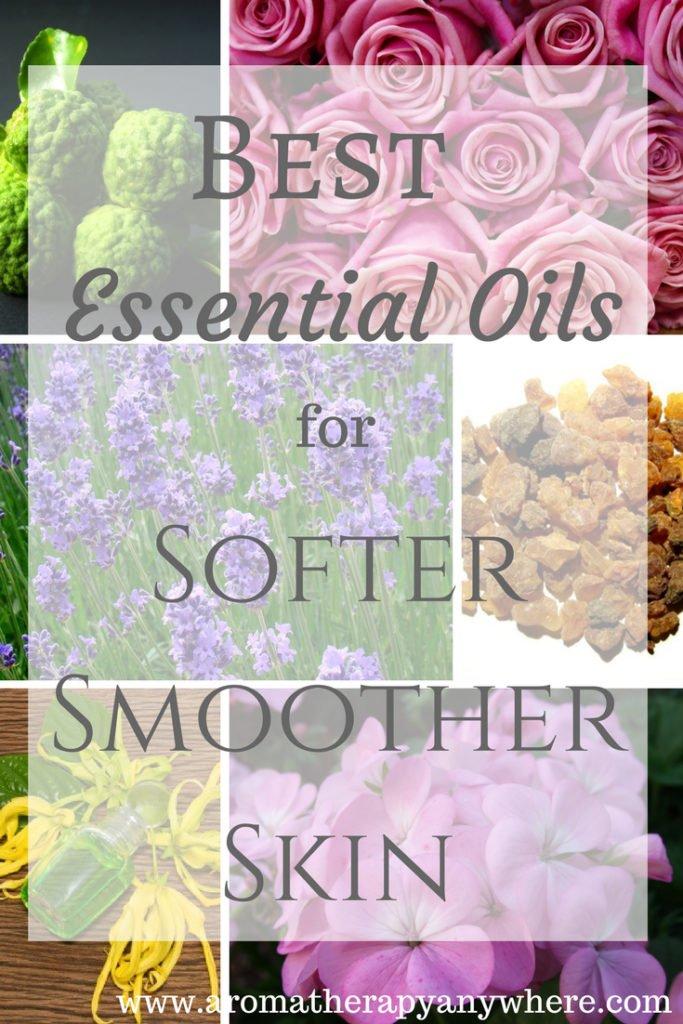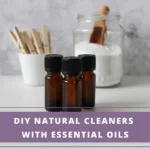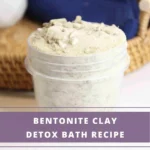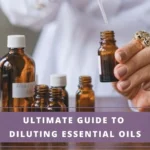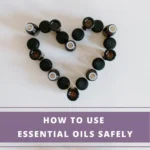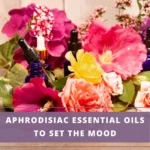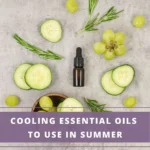As an Amazon Associate I earn from qualifying purchases. See Full Disclosure Here
The best essential oils for the skin work gently and naturally to moisturize and soften your skin so it looks smoother and younger without any of the potential side effects inherent in chemical lotions.
As the benefits of essential oils for skin are becoming better-known, more and more health and beauty care experts are ditching synthetic products and are now switching over to using essential oils for the skin.
At home too, more people are recognizing the benefits of essential oils for skin and are using pure and natural products as part of their daily skin care regimen. I am one of them.
Even skincare products that claim to contain only organic and natural ingredients do end up containing some amount of additives or preservatives. This can be a major irritant if you have sensitive skin like me.
After some more reading about the benefits of essential oils for skin, I’ve changed my skincare regimen completely and have moved over to using essential oils for the skin.
Skincare Facts & the Benefits of Essential Oils for Skin
Our skin is permeable and absorbs whatever cream or lotion you apply over it. This is why you need to be especially careful of what you rub onto your skin. All-natural products beat their chemical counterparts any day.
You must take the time to read the labels of products you intend to apply on your skin to ensure that the product does not contain any harmful chemicals.
Very few people actually take the trouble to go through the labels of topical skins and lotions, which is a mistake. When you actually do read through the ingredients, you’ll be in for a surprise. Most products contain a laundry list of chemical ingredients.
Choosing natural based products over synthetics allows us to pamper and beautify our skin without absorbing harmful toxins. As you read about the benefits of essential oils for skin, you will realize that the single best thing you can do is use organic essential oils for the skin.
The added benefit is that the scent of these botanical essential oils stimulates the release of neurochemicals in the brain invoking a positive effect not only on the skin but also in your mind and body.
 12 Best Essential Oils For The Skin
12 Best Essential Oils For The Skin
Take a look at some of the best essential oils for skin. These will help to protect your skin from UV rays, reduce acne flare-ups and breakouts, keep your skin softer and suppler, and generally pamper and moisturize your skin gently and naturally.
1. Geranium
Geranium is one of the top essential oils for the skin.
Its gentle balancing action makes geranium essential oil good for all skin types, including dry, oily and sensitive skin. The oil also works well to soothe and moisturize irritated skin.
The ability of the oil to regulate oil production and reduce breakouts and flare-ups makes it particularly beneficial for anyone suffering from acne.
This essential oil has cytophylactic properties, which helps hamper cell breakdown, while at the same time stimulating cellular regeneration. These properties make geranium oil very effective for reducing wrinkles, tightening aging skin and improving the skin’s elasticity.
Geranium essential oil also works wonders for treating burns, bruises, wounds and other injuries and related skin problems because of its haemostatic property that helps stop bleeding. Its microbial and antibacterial properties also help prevent the development of infections on skin wounds.
2. Lavender
You cannot leave out lavender when talking about the benefits of essential oil for skin.
Lavender oil has an almost miraculous ability to heal the skin by boosting the regeneration and replacement of skin cells. This makes it the number one essential oil for treating burns, wounds, and cuts, and reducing wrinkles, sun spots and scars.
Gentle-scented lavender is known to be lethal to micro-organisms that cause skin disease. The oil functions by destroying fungal cell membranes, making it highly potent for managing fungal infections.
Lavender essential oil’s antifungal and antiseptic properties are useful for treating a wide range of skin problems from psoriasis and acne to wrinkles and skin inflammations.
It can also be used for soothing insect and bug bites and combined with chamomile oil for treating eczema.
3. Bergamot
Bergamot contains disinfectant and antibiotic properties that help ward off micro-organisms that can cause skin infections. Its antibacterial properties make bergamot one of the best essential oils for the skin if you are prone to getting acne and blackheads.
Bergamot essential oil also helps regulate oil production in the skin which is another reason why it works so effectively against acne. It also has the ability to kill bacteria before it starts causing pimples and blackheads. The oil’s antiseptic properties encourage skin regeneration, which helps wounds heal faster
Bergamot’s popularity in the field of skin care can also be attributed to its ability to regulate the distribution of melanin that helps even out skin tone. Bergamot oil is often used to diminish stretch marks, fade scars caused by eczema, cold sores, acne, and psoriasis, and hinder the development of new scars.
4. Ylang Ylang
When you are exploring the benefits of essential oil for skin, you cannot overlook Ylang Ylang.
Ylang Ylang essential oil has several properties that make it one of the favored essential oils for the skin. It boosts regeneration of skin cells, controls oil production, minimizes fine lines, improves the skin’s elasticity and reduces breakouts.
This essential oil can be used for any skin type and is great for reducing the signs of aging.
When you are making your own skin or beauty products, you will find that a lot of DIY recipes call for Ylang Ylang. It is often found in all-natural face and hand creams and is very effective if you have acne or very oily skin.
Ylang Ylang oil is also a major ingredient in elixirs that are formulated to naturally remove fine lines and wrinkles.
5. Myrrh
The potent anti-inflammatory properties of Myrrh make it one of the most effective of all the essential oils for aging skin.
When used regularly, it works very well to improve the skin’s elasticity. This reduces the appearance of fine lines and wrinkles so the skin feels smoother and more supple.
Myrrh essential oil is also great for treating chapped skin, rash, and eczema, and works well to soothe sun-damaged skin.
6. Lemongrass
Lemongrass is another good essential oil for the skin.
It acts as an effective astringent and works really well for skin conditions such as acne and large pores, as well as for use as a skin toner.
Most store-bought astringent and skin toner products contain strong chemicals that are much too harsh for your skin. Lemongrass essential oil, on the other hand, contains only pure, natural ingredients and is light and gentle. It gives the skin a healthy, vibrant glow without causing any irritation.
Lemongrass essential oil is best mixed with a carrier oil such as jojoba, coconut, or grapeseed oil before applying onto yourskin.
7. Carrot Seed
Carrot seed essential oil promotes cell regeneration, which helps revitalize aging skin and keeps it looking smoother and younger.
This oil is also rich in antioxidants, which help keep wrinkles at bay by neutralizing free radicals.
Its cell-regenerating properties make carrot oil very effective for minimizing the appearance of blemishes and scars. It works wonderfully for all skin types.
8. Neroli
Neroli has several properties that put it high on the list of best essential oils for the skin. It is widely used to tone and tighten skin, reduce age lines and rejuvenate aging skin.
The oil is rich in citral, a natural chemical known for its rejuvenating properties. This makes neroli essential oil great for toning sagging skin and smoothing fine lines and wrinkles.
Neroli essential oil works great for all types of skin including oily, aging, and sensitive skin.
9. Frankincense
The antibacterial and anti-inflammatory properties of frankincense make this another one of the popular essential oils for the skin, particularly for treating acne.
Its rejuvenating properties promote cell growth, which helps to tighten the skin and reduce the appearance of fine lines, wrinkles, and scars.
Frankincense essential oil also acts as a natural skin toner. When applied to your skin, it minimizes the visibility of large pores and evens out the skin tone.
10. Rose
Well known for its soothing, calming effects when used in aromatherapy, rose oil is also one of the more popular essential oils for the skin, especially dry and aging skin.
Regular application of rose essential oil helps refine the tone and texture of the skin, while its antimicrobial and anti-inflammatory properties make it very effective in treating a variety of skin conditions such as psoriasis and dermatitis.
11. Tea Tree
My teenage son used tea tree essential oil for acne and I can vouch for the fact that it works. Yes, it does take some time but be patient and persistent and you will see the results.
The reason tea tree oil works so well to reduce acne is due to its powerful antibacterial properties and also because of its ability to balance the production of oil. Both of these properties work together to reduce the frequency and severity of acne breakouts and to minimize the development of acne scars.
No matter what your age, if you suffer from acne, you will find that this is definitely one of the better essential oils for the skin. It’s gentler than over-the-counter acne lotions, yet still as effective.
12. Patchouli
Patchouli essential oil works to reduce the appearance of age lines and wrinkles by promoting new cell growth that plumps out the skin. This also makes the skin look more youthful.
This essential oil for the skin also has potent antibacterial, antifungal, and antiseptic properties, which make it effective in treating psoriasis and dermatitis. It also works well to reduce the visibility of acne scars.
Note About Using Carrier Oils When Using Essential Oils For The Skin
To get the maximum benefits of essential oils for skin, it is important to use them regularly and more importantly, correctly.
When using any essential oil for the skin you must use it with a carrier oil. Here’s how to blend the oils.
Put a few drops of your preferred essential oil or a combination of oils into a glass container.
Add 2 tablespoons of the appropriate carrier oil into the container and mix well.
Massage a small amount of this blend into your skin gently for a few minutes and leave it on.
Read more about using carrier oils for essential oils.
List Of Carrier Oils To Use To Get The Benefits Of Essential Oils For Skin
Carrier oils dilute the potency of strong essential oils and also make them easier to apply and massage into the skin.
The best carrier oils to use will depend on your skin type:
Best carrier oils for oily skin – Grapeseed oil, Jojoba oil, Sweet Almond oil
Best carrier oils for dry or aging skin – Avocado oil, Argan oil, Apricot Kernel oil,
Best carrier oils for all skin types – Coconut oil, Olive oil, Sunflower oil
Making Your Own Essential Oil Blends For The Skin
What I’ve listed are just some of the many essential oils for the skin. As you learn more about the benefits of essential oils for skin, you can start to experiment slowly and discover many more effective combinations that work well for your particular skin type.
Caution– When making your own unique skincare blends, always start by applying to a small area to test for sensitivity. The best place to try is on the inside of your wrist.
Once you have found something that works for your skin type, you can also make your own personalized creams and lotions that you can pack along with you when traveling.
Why wait for tomorrow? Pick up any one of your preferred essential oils for skin today.
Disclaimer: This information is not intended to serve as medical advice. Please consult your physician before using essential oils. See Full Disclaimer here.

